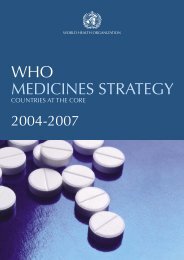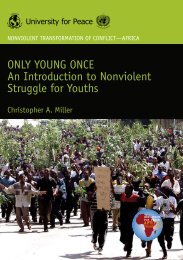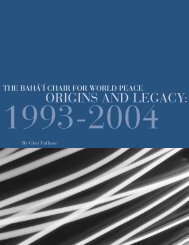environmental degradation as a cause of conflict in - Steiner Graphics
environmental degradation as a cause of conflict in - Steiner Graphics
environmental degradation as a cause of conflict in - Steiner Graphics
You also want an ePaper? Increase the reach of your titles
YUMPU automatically turns print PDFs into web optimized ePapers that Google loves.
to <strong>conflict</strong>s between the nomads and the farmers.• The weaken<strong>in</strong>g and politicization <strong>of</strong> the traditional local adm<strong>in</strong>istrative systemh<strong>as</strong> underm<strong>in</strong>ed its effectiveness <strong>in</strong> m<strong>in</strong>imiz<strong>in</strong>g <strong>conflict</strong>s between thep<strong>as</strong>toralists and the farmers.• The lack <strong>of</strong> development <strong>in</strong> the agricultural sector to <strong>in</strong>cre<strong>as</strong>e real productivityh<strong>as</strong> led to horizontal expansion and <strong>in</strong>cre<strong>as</strong>ed friction between animalsand agriculture.• Governmental policies and its strategy <strong>in</strong> manag<strong>in</strong>g the gr<strong>as</strong>sroots issues,especially those regulations that are not b<strong>as</strong>ed on suitable and practicalways, such <strong>as</strong> sell<strong>in</strong>g <strong>of</strong> unattended animal fences to the merchants <strong>in</strong> thevillages <strong>as</strong> a source <strong>of</strong> revenue, the communal – talaig – regulations havesubstantially <strong>in</strong>tensified the present friction and <strong>conflict</strong>s between the farmersand the p<strong>as</strong>toralists.RecommendationsFrom the above conclusions, the follow<strong>in</strong>g recommendations are proposed for considerationby the concerned bodies <strong>in</strong> order to m<strong>in</strong>imize <strong>conflict</strong> between the stakeholdersand thus contribute to peacebuild<strong>in</strong>g <strong>in</strong> Darfur:• The development and improvement <strong>of</strong> agricultural and livestock sectorsthrough scientific means to <strong>in</strong>cre<strong>as</strong>e productivity and thus decre<strong>as</strong>e frictionand <strong>conflict</strong> between the stakeholders <strong>in</strong> the two sectors.• The abolition <strong>of</strong> communal graz<strong>in</strong>g <strong>in</strong> the agricultural are<strong>as</strong> throughout theyear. Abolish<strong>in</strong>g the talaig regulations would mutually benefit both the farmersand the animal breeders. This, <strong>in</strong> turn, would <strong>in</strong>itiate and encouragefodder cultivation and thus develop the animal production substantially.• Camel rais<strong>in</strong>g h<strong>as</strong> become very expensive and with a very low growth andreturn. Camel nomads should be encouraged to shift from camel breed<strong>in</strong>g tosheep rais<strong>in</strong>g which is more fe<strong>as</strong>ible.• The far north underground water aquifers (Um Byada, Wadi Hawar b<strong>as</strong><strong>in</strong>s)should be used through the drill<strong>in</strong>g <strong>of</strong> boreholes, and used for fodder productionfor the p<strong>as</strong>toral communities.• Monitor<strong>in</strong>g and stopp<strong>in</strong>g the Chadian camel herders from enter<strong>in</strong>g Darfurshould be considered, be<strong>cause</strong> they are the ma<strong>in</strong> <strong>cause</strong> for most <strong>of</strong> the <strong>conflict</strong>sbetween the p<strong>as</strong>toralists and farmers <strong>in</strong> Darfur.43











